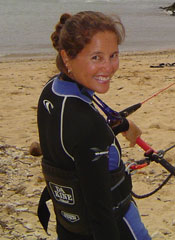Jean Hamai
TOPS Teacher for Deep Impact

What do you think is the coolest thing about Deep Impact?
The coolest thing is that we will actually be able to participate in this event. We hope to do this by observing the comet before during and after impact, in real time from Hawaii!
What value do you think the mission will have for students?
The first has to do with making science real. By being a part of this event, students will see that science is a part of their lives. Secondly, it raises some very good discussion questions about our place in science and the universe. It is important for students to think about these missions and consider their values and impacts (pros and cons) so that thoughtful decisions can be made in their own future.
How did you get involved with Deep Impact?
I was a teacher participant in the 5-year TOPS (Towards Other Planetary Systems) workshop sponsored by NSF and the Institute for Astronomy at the University of Hawaii. During this workshop, I found out about the Deep Impact mission.
What do you do in your spare time?
Kitesurf as much as I can. Maui is a wind machine and has been great for my kiting!
What is your connection to education?
I have been a math teacher in Hawaii for the past 12 years but have always been interested in science. I was an electrical engineer first so I try to look for ways to integrate science and real world events into my math curriculum. Personally, I never stop learning.
What is one of your yet-to-be-achieved goals?
This one is hard as I feel I've accomplished a lot of those goal-type of things (engineering, the Ironman triathlon, sailed across the ocean, kitesurf). Now I am more in a place where I want to do a good job in what I do, be fulfilled by it and be happy. Also work on friendships since they do take time and effort and travel more. I need to see more of the world which is important as it broadens one's perspectives.
What do you hope to learn from the Deep Impact mission?
I would like to learn how to do more astronomy research projects with my students where we start out with something we would like to know and then use some of the really great technology that is around us to answer these questions.
Where will you be and what will you be doing during encounter?
I hope to be on Maui observing the impact with my students remotely via the Faulkes telescope that sits atop our Haleakala crater.
Who inspired you to an interest in science and astronomy?
My best friend, Ramona Gaylord. As a science teacher, she showed me some really cool things in her telescope and got me hooked. I never saw simple things like the craters on the moon or moons of Jupiter! I then studied Polynesian Voyaging that led me to an interest in celestial navigation or wayfinding and it continued from there.
Were you interested in space as a child?
Astronomy was not taught at the school I went to and growing up on Maui, I was more interested in the ocean than the stars.
What was your favorite book as a child?
I read constantly. I always had a book with me as an escape but I really can't pick one book that stands out right now.
What did you want to be when you grew up when you were young?
I wanted to be a social worker and help people but by the time I got to High school I realized there was no money so I went into engineering instead. That is a great degree to have because it has so many applications. Now as a teacher, I feel like I get the best of both worlds: helping students and learning about ways to integrate math, science and real world issues.











